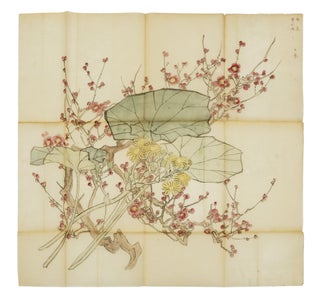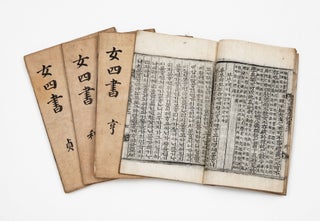E-Bangire
An e-bangire (writing-paper edition), depicting six of the main characters from Shui hu zhuan [J: Suikoden; Water Margin [or] Outlaws of the Marsh].
Six large & fine color-printed woodcuts on six sheets, joined together. Narrow orihon format (321 x 72 mm.; sheet lengths: 357, 425, 420, 425, 415, & 283 mm.), orig. stiff boards, endpapers with gold speckling. [Japan: late Edo or Meiji era].
A very rare example of e-bangire (or ehankiri or ebankiri or ebangiri): woodcut prints using pale colors and printed on half sheets of sugiharagami writing paper. The half-sheet illustrations were then joined together, forming narrow orihon. E-banigire, which literally means “printed on paper that has been cut in half,” rarely survive.
“The novel [Shui hu zhuan] tells of the growth of the Shantung bandit group headed by Sung Chiang, its honorable surrender to the government, the subsequent campaigns against the Liao Kingdom and other rebellious groups, and its fatal but successful final mission.”–Nienhauser, ed., The Indiana Companion to Traditional Chinese Literature, p. 712.
Water Margin had a great influence in China and throughout East Asia, especially Japan. “Probably the most widely disseminated of all recent Chinese texts in the Tokugawa period were some of the best-known examples of Ming fiction. The fictional literature of the Ming dynasty inspired and shaped a great deal of Japanese fiction in the late eighteenth and early nineteenth centuries, especially the genre of long and largely historical narratives known today as yomihon. Undoubtedly the most influential Ming work was Shui hu chuan, the ‘Water Margin,’ which inspired a number of Japanese adaptations.”–Kornicki, The Book in Japan, p. 299.
This e-bangire depicts six of the major figures of Shui hu zhuan: Shi jin (J: Shishin), Lu Zhishen (Rochishin), Dongping (Tohei), Wu Song (Busho), Zhang Shun (Chojun), and Gongsun Sheng (Kosonsho).
The six fine and large, dramatic woodcuts are printed in pale pink, green, gray, and brown (there are several shades of pink and green). There is very refined bokashi in almost all the woodcuts. As usual, the generous upper margins are deliberately left blank for calligraphic additions. The woodcuts are quite complex and sophisticated.
In fine condition. There is some minor worming. The first image has four wormholes, one of which affects the landscape behind Shi jin. The third image has a small wormhole, and the fifth has several small wormholes in the blank area. In the final woodcut, there is a small wormhole in a blank area.
Price: $2,250.00
Item ID: 8572

![Item ID: 8572 An e-bangire (writing-paper edition), depicting six of the main characters from Shui hu zhuan [J: Suikoden; Water Margin [or] Outlaws of the Marsh]. E-BANGIRE: SHUI HU ZHUAN.](https://jonathanahill.cdn.bibliopolis.com/pictures/8572.jpg?width=768&height=1000&fit=bounds&auto=webp&v=1671555989)
![An e-bangire (writing-paper edition), depicting six of the main characters from Shui hu zhuan [J: Suikoden; Water Margin [or] Outlaws of the Marsh].](https://jonathanahill.cdn.bibliopolis.com/pictures/8572_2.jpg?width=320&height=427&fit=bounds&auto=webp&v=1671555989)
![An e-bangire (writing-paper edition), depicting six of the main characters from Shui hu zhuan [J: Suikoden; Water Margin [or] Outlaws of the Marsh].](https://jonathanahill.cdn.bibliopolis.com/pictures/8572_3.jpg?width=320&height=427&fit=bounds&auto=webp&v=1671555989)


![Catalogue des Livres provenans de la Bibliotheque de M.L.D.D. L. V. [Duc de la Vallière]. AUCTION CATALOGUE: LA VALLIÈRE.](https://jonathanahill.cdn.bibliopolis.com/pictures/2943.jpg?width=320&height=427&fit=bounds&auto=webp&v=1475847348)
